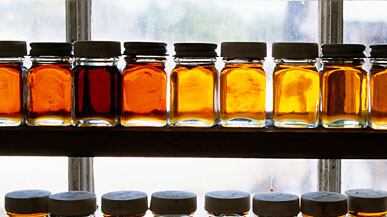Now that winter has finally released its frozen grip across Quebec and New England, this year’s maple sugaring season was extraordinarily bountiful, say amateur sap tappers, many of whom tapped for the first time during this spring’s thaw. In a sap-reduction process first perfected by Indian tribes across eastern North America before the first European explorers arrived, maple syrup was named by one Indian Chief as sinzibuckwud—a word meaning “drawn from trees,” referring to the sugary sap tapped, collected and boiled down from maple trees every spring, according to one historical account.
This sweet condiment certainly caught on with American colonists. Founding father Ben Franklin, in all his home-spun wisdom, enthusiastically promoted maple sugaring as an ideal way to wean the country’s dependence on expensive imported sugar from the West Indies, while also encouraging the nascent domestic economy.
Today, more than four centuries later, the annual production of maple syrup runs into millions of gallons and hundreds of millions of dollars in the U.S. and Canada; maple syrup, maple candy and other related products comprise a very big business, whose geographic reach stretches from the northern Midwest east to New England as well as Quebec, Nova Scotia and Prince Edward Island in Canada. Long dominated by family-owned firms possessing large tracts of sap-producing trees, a new breed of maple-mad sap-suckers have been pulling on their L.L. Bean mud boots, battling vicious, bone-rattling potholes on mucky back roads throughout Northeast, and tapping trees like it’s 1492!
ADVERTISEMENT
In Search of “Vermont Crude”
Out among groves of sugar bush—a term used in New England to describe a stand of rock, hard and black maple trees or red maples—amateur sap-tappers diligently panned for this season’s liquid gold. When boiled down gradually on stoves or outside on small-scale sap evaporators that addictive sweet syrup yields quality grades from the translucent AA Light Amber to the robustly flavored, deep russet tints of a Dark Amber B. Vermont natives often call sap “Vermont crude” because it’s so valuable: 40 gallons of raw sap are needed to yield one gallon of syrup. A gallon of Fancy, Grade A Light pure maple syrup sells for almost $60 within Vermont, and for much more in gourmet boutiques and supermarkets across the nation.
In recent months, do-it-yourself hobbyists like Raymond T. Doherty of Woodstock, New York, have been busy tapping with extremely sweet results. He owns about four densely forested acres a few miles outside of town. Having collected more than 60 gallons to date, Doherty has carefully boiled down the sap on his stovetop and bottled more than a gallon of home-made Grade B nectar.
Lighter grades of maple (AA and A) are more delicately flavored, with floral and fruity aromas, while darker grades like B or Dark Amber feature heartier, nuttier, woodsy savors.

How did it all start? “A friend found eight antique 19th century sugar maple iron sap-taps and gave them to me as a gift, then I purchased some old galvanized steel sap buckets on eBay, read up about how to make maple syrup at home, and, over the last few weeks, I have been busy having fun tapping 10 sugar maples on my property,” Doherty said.
“It has been a great year for the backyard maple sugar enthusiast. Everyone is coming in and buying us out, from taps and sap buckets to candy thermometers, which measure sugar levels in the sap,” reports Vince Christofora, owner of Woodstock Hardware in Woodstock, New York.
While there is much debate among maple syrup connoisseurs whether A grades are superior to B or, Dark Amber grades, the consensus is that lighter grades of maple (AA and A) are more delicately flavored, with floral and fruity aromas, while darker grades like B or Dark Amber feature heartier, nuttier, woodsy savors.
But when faced with a stack of steaming pancakes or waffles, purists demur and pour pure maple syrup on with abandon with whatever grade that is on offer!
Here are three guaranteed-to-please recipes for your pure maple syrup, either home-made or store-bought:
MAPLE MADNESS FOOL-PROOF FLAPJACK RECIPE
(Serves 2- 4, depending on hunger!)
In this recipe, I substitute pure maple syrup for sugar, an ingredient one traditionally sees in most pancake mix recipes. (If you don’t use self-rising flour, regular flour and two teaspoons of baking powder is a good substitution.)
INGREDIENTS: 2 1/4 cups self-rising flour 2 teaspoons pure maple syrup (any grade) 2 cups whole milk 1/4 stick (2 tablespoons) of unsalted butter, to melt 4 large eggs, separated Additional melted butter, if needed Pure maple syrup
PREPARATION STEPS: Mix self-rising flour in large bowl, ready to blend. Pour in milk, egg yolks in medium bowl and whisk. Pour milk-and-egg yolk mixture into large bowl of flour and whisk. Pour 2 tablespoons melted butter and whisk until flapjack batter is creamy.
In a medium bowl, beat egg whites until soft peaks appear. Pour in pure maple syrup; beat mixture until peaks are formed. Fold ½ egg-white/maple syrup mixture into batter, mix gently; then fold in second ½ half into batter, mix gently.
Over medium heat, warm up a cast-iron griddle or large skillet; a non-stick griddle or pan will do as well. Generously brush griddle or pan surfaces with melted butter. For each pancake, pour a generous dollop (up to 1/4 cup) on the skillet or griddle. After 2-3 minutes, check bottom, if brown, gently use spatula and flip the flapjack, cook another 2 minutes or so, until bottom is brown and flapjack is cooked. Place on serving plate, keep warm in oven; repeat until batter is used up. Serve with pure maple syrup and warm, melted butter to taste. (Note: Avoid repeated flips of flapjacks, be patient, let each side brown!)
Transfer to plates. Serve warm with warmed pure maple syrup; I recommend Grade B, Dark Amber.
MAPLE SYRUP-INSPIRED NESTLÉ® TOLL HOUSE CHOCOLATE CHIP COOKIE RECIPE
About 30-60 cookies, depending on size of cookie
This version of Nestlé’s Toll House classic chocolate cookie recipe substitutes pure maple syrup—again any grade is perfect, but I recommend Grade B, Dark Amber—in place of the traditional sweetener, a blend of white and brown sugar.
INGREDIENTS:2 1/4 cups all-purpose flour 1 teaspoon baking soda 1 teaspoon salt 1 cup (2 sticks) butter, softened 1 1/2 cups of pure maple syrup 1 teaspoon vanilla extract 2 large eggs 2 cups (12-oz. pkg.) NESTLÉ® TOLL HOUSE® Semi-Sweet Chocolate Morsels
PREHEAT oven to 375° F.
COMBINE flour, baking soda and salt in small bowl. Beat butter, pure maple syrup and vanilla extract in large mixer bowl until creamy. Add eggs, one at a time, beating well after each addition. Gradually beat in flour mixture. Stir in morsels and nuts. Drop by rounded tablespoon onto ungreased baking sheets.
BAKE for 9 to 11 minutes or until golden brown. Cool on baking sheets for 2 minutes; remove to wire racks to cool completely.
PAN COOKIE VARIATION: Grease 15 x 10-inch jelly-roll pan. Prepare dough as above. Spread into prepared pan. Bake for 20 to 25 minutes or until golden brown. Cool in pan on wire rack. Makes 4 dozen bars.
SLICE AND BAKE COOKIE VARIATION: PREPARE dough as above. Divide in half; wrap in waxed paper. Refrigerate for 1 hour or until firm. Shape each half into 15-inch log; wrap in wax paper. Refrigerate for 30 minutes.* Preheat oven to 375° F. Cut into 1/2-inch-thick slices; place on ungreased baking sheets. Bake for 8 to 10 minutes or until golden brown. Cool on baking sheets for 2 minutes; remove to wire racks to cool completely. Makes about 5 dozen cookies. * May be stored in refrigerator for up to 1 week or in freezer for up to 8 weeks.
FOR HIGH-ALTITUDE BAKING (5,200 feet): Increase flour to 2 1/2 cups. Add 2 teaspoons water with flour and reduce maple syrup to 1 and 1/3 cups. Bake drop cookies for 8 to 10 minutes and pan cookie for 17 to 19 minutes. Recipe copy above adapted from NESTLÉ®.
MAPLE LEAF COCKTAIL
This springtime libation is a delicious variation on the classic Whiskey Sour. Here’s to your health!
1 1/2 ounces Bourbon 1/2 ounce pure maple syrup, Grade A, Fancy, the lightest hue available 1/2 ounce fresh lemon juice
Place all ingredients in a cocktail shaker with ice. Shake and strain into a cocktail glass.
Recipe created by Nora Maynard and originally posted on TheKitchn.
David Lincoln Ross writes about food and wine from New York City. For more information, please visit: www.davidlincolnross.com






